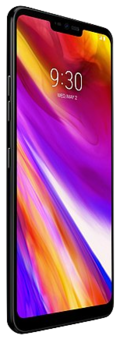| | |
 | |
| Brand | G series |
|---|---|
| Manufacturer | LG Electronics |
| Type | Smartphone |
| Predecessor | LG G6 |
| Successor | LG G8 ThinQ |
| Related | LG V40 ThinQ, LG Q6, LG Q7, LG Q9 |
| Form factor | Slate |
| Dimensions | 153.2 x 71.9 x 7.9 mm (6.03 x 2.83 x 0.31 in) |
| Weight | 162 g (5.75 oz) |
| Operating system | Original: Android 8.0 "Oreo" Current: Android 10/11 Unofficial alternative: Android 14 |
| System-on-chip | Qualcomm Snapdragon 845 |
| CPU | Octa-core (4x 2.8GHz & 4x 1.8GHz) Kryo |
| GPU | Adreno 630 |
| Memory | 4 GB/6 GB LPDDR4 RAM |
| Storage | 64 or 128 GB |
| Removable storage | microSDXC |
| Battery | 3000 mAh Li-Po, non removable |
| Rear camera | 16 MP (f/1.6, OIS) + 16 MP wide angle (f/1.9), active autofocus, LED flash 2160p@30/60fps 1080p@30/60fps, Slow-Motion 720p@240fps, HDR10, stereo sound rec. |
| Front camera | 8 MP, f/1.9, 1080p |
| Display | 6.09 in (155 mm) (full rectangle) 5.94 in (151 mm) (without notch) 3120 × 1440 1440p IPS LCD (19.5:9 aspect ratio) (564 ppi) Dolby Vision HDR10 |
| Sound | Mono "boombox" speaker, 3.5 mm stereo audio jack |
| Connectivity | Type-C 1.0 reversible connector + 802.11 a/b/g/n/ac Wi-fi, dual-band + Bluetooth 5.0 + NFC + Radio + GPS |
| Data inputs | Fingerprint (rear-mounted), accelerometer, gyro, proximity, compass, barometer, color spectrum |
| Website | https://lg.com/us/mobile-phones/g7-thinq |
The LG G7 ThinQ, commonly referred to as just LG G7, [1] is an Android smartphone developed by LG Electronics as part of the LG G series. It was officially announced on May 2, 2018, after about a week of official leaks by LG. It is the second product from LG that uses the ThinQ branding. [2] The device serves as the successor to the 2017 LG G6.